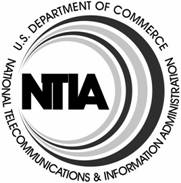NTIA seeks feedback on future airwaves for innovative technologies; SpectrumX to host a listening session at the University of Notre Dame

Released: March 15, 2023
By NTIA, Office of Public Affairs
WASHINGTON – The Department of Commerce’s National Telecommunications and Information Administration (NTIA) on Wednesday began seeking comment on identifying airwaves for more intensive use and innovative new uses by both the private sector and federal agencies.
NTIA’s National Spectrum Strategy Request for Comment seeks input on creating a spectrum pipeline for the next decade of frequencies that could be studied for new or additional uses. The agency’s goal is to identify at least 1,500 megahertz of spectrum to study for potential repurposing – perhaps the most ambitious study goal for NTIA to date – to meet future requirements for non-federal and federal users.
Developing a strategy to increase access to this finite resource will help ensure continued U.S. leadership in emerging technologies, advance connectivity and competition, create jobs and produce improvements to overall quality of life.
“Over the last decade, the U.S. has led the world in developing and deploying advanced technologies, many of which rely upon access to radiofrequency spectrum,” said U.S. Secretary of Commerce Gina Raimondo. “With this announcement, we will ensure that America continues to lead into the next decade. Starting today, we are seeking input on how we can make the most efficient use of this critical resource, with the goal of identifying new spectrum bands for potential repurposing that will spur competition and innovation for years to come.”
“Practically every part of American life—from our digital economy to our national defense—runs on spectrum. To keep driving innovation and maintain our country’s wireless leadership, we have to make the best possible use of this scarce resource,” said White House Office of Science and Technology Policy Director Arati Prabhakar. “Feedback and ideas from spectrum users across the United States will help us develop a National Spectrum Strategy that meets the needs of today and tomorrow.”
“Demand for America’s scarce spectrum resources continues to grow,” said Alan Davidson, Assistant Secretary of Commerce for Communications and Information and NTIA Administrator. “Our National Spectrum Strategy will help to ensure that innovators and entrepreneurs can access the spectrum resources they need to bring exciting new products and services to market, and that government missions can meet the demands of the 21st century.”
The National Spectrum Strategy is intended to address the current and future needs of spectrum-driven services, including:
- Fixed and mobile wireless broadband services;
- Next-generation satellite communications and other space-based systems;
- Advanced transportation technologies;
- Industrial and commercial applications, such as for manufacturing, agriculture, and utilities;
- Wireless medical devices and telemedicine;
- Internet of Things (IoT) and smart cities; and
- Critical government missions, such as national defense, safeguarding the national airspace, securing the Nation’s critical infrastructure, climate monitoring and forecasting, and other scientific endeavors.
The request for comment seeks input from a diverse range of stakeholders, including private industry academia, civil society and the public sector, on three proposed pillars of the National Spectrum Strategy.
- Developing a spectrum pipeline: What are the requirements such a pipeline needs to address? Which spectrum bands may be best suited for particular purposes, what access approaches should we consider, and what are the benefits and tradeoffs of each band or approach?
- Long-term spectrum planning: What should a long-term planning process entail? Who are the key stakeholders and what are the key inputs? How can the necessary collaboration best be implemented and executed?
- Expanding spectrum capacity through technology: What innovations on spectrum management models are coming? What spectrum management capabilities/tools would enable more robust and quicker implementation of spectrum sharing?
NTIA intends to develop its strategy by the end of this year based on feedback to these questions and more. NTIA Senior Spectrum Advisor Scott Blake Harris will spearhead this work as Director of National Spectrum Strategy. Listening sessions will be held March 30 in Washington, D.C. and April 11 at the University of Notre Dame, hosted by SpectrumX – an NSF Center for Spectrum Innovation. Both sessions will also be available via webcast. Comments will be due 30 days from publication in the Federal Register.
About the National Telecommunications and Information Administration
The National Telecommunications and Information Administration (NTIA), part of the U.S. Department of Commerce, is the Executive Branch agency that advises the President on telecommunications and information policy issues. NTIA’s programs and policymaking focus largely on expanding broadband Internet access and adoption in America, expanding the use of spectrum by all users, advancing public safety communications, and ensuring that the Internet remains an engine for innovation and economic growth.
News Media Contact:
NTIA, Office of Public Affairs, press@ntia.gov
Original press release: https://ntia.gov/press-release/2023/ntia-seeks-feedback-future-airwaves-innovative-technologies
About SpectrumX – An NSF Spectrum Innovation Center
SpectrumX is funded by the National Science Foundation (NSF) as part of its Spectrum Innovation Initiative, under grant number AST 21-32700. SpectrumX is the world’s largest academic hub where all radio spectrum stakeholders can innovate, collaborate, and contribute to maximizing social welfare of this precious resource.
To learn more about SpectrumX, please visit spectrumx.org.
SpectrumX Contact: Tiffanie Sammons, SpectrumX and Wireless Institute, is the University of
Notre Dame’s logistics point of contact, tsammon1@nd.edu.